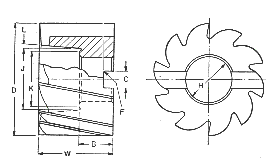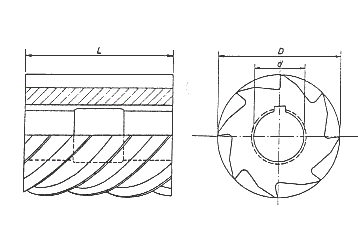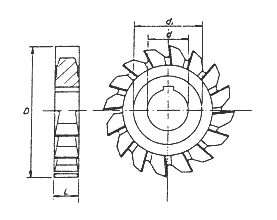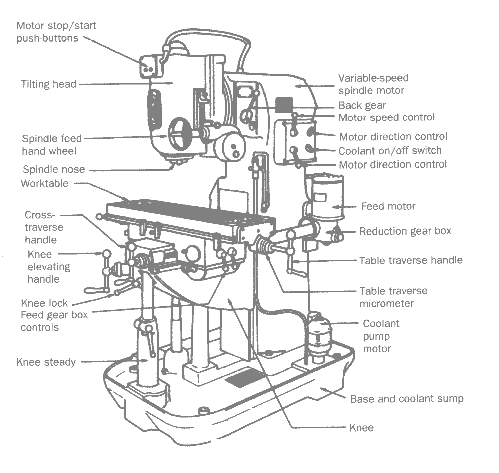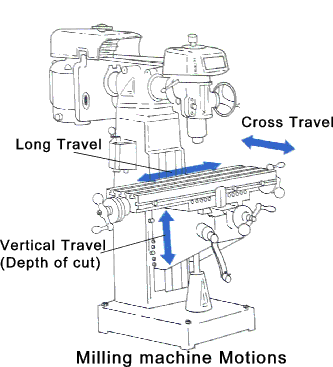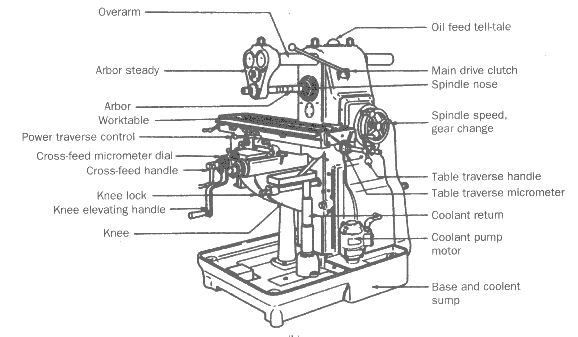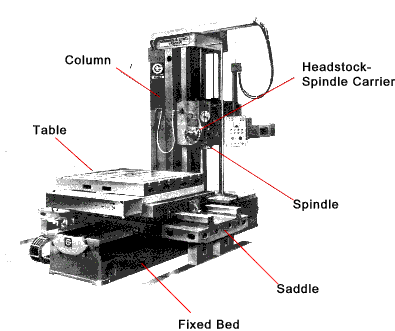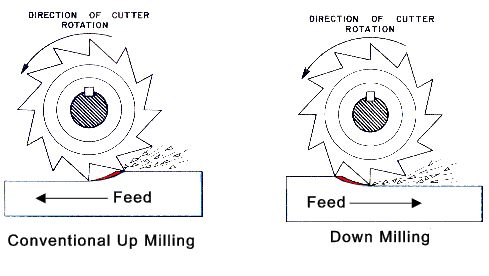|
|
|
Machining
Milling Machines
|
Introduction A milling machine is a machine tool that cuts metal with a multiple-tooth cutting tool called
a milling cutter.
The workpiece is fastened to the milling machine table and is fed against
the revolving milling cutter.
The milling cutters can have cutting teeth on the periphery or sidesor both.
The cutting teeth can be straight or spiral.
Milling attachments can also be fitted to other machine tools including lathes planing machines and drill bench presses can be used with milling cutters.
Additional Notes Milling Cutters There are a wide range of milling cutters as illustrated in BS 122-1. these include
Tee Slot Milling Cutter
Shell End Mill
High Helix Cylinderical Cutter
Slotting Cutter Relevant Standards
BS 122-1:1953..Milling cutters. Milling cutters Column and Knee Machine -Vertical Milling Machine
Vertical milling machines have their cutting tool spindles vertical and are characterised by
by their heavy overarms which are integral with their columns. This provides rigid support
for the spindle housing which is set at a fixed distance from from the column.
The milling head can be adjusted vertically
Column and Knee Machine - Horizontal Milling Machine
This is the basic milling machine configuration. The workpiece can be fed in
all three axes and is suitable for short production runs but it is not as rigid as a fixed bed machine
and should not be used for heavy duty work.
Because of the large number of controls it is relatively slow to operate.
Fixed Bed Milling Machines Fixed bed or production type machines are designed for rapid metal removal requiring the minimum of operator involvement. On this type of machine the table is fixed permitting machine table movement in one horizontal direction only. the workpiece has to be fixed in one location on the table and all vertical movements for feeds and lateral positioning are by moving the spindle in the spindle carrier mounted on the headstock. A plain machine has just one spindle and a duplex machine has two spindles. this type of machine can have one column or two columns providing more rigidity.
Horizontal Milling Feed Direction The direction of feed in relation to the direction of cutter rotation is and important factor
in horizontal milling. Conventional up milling requires that the workpiece is fed
against the rotation of the cutter. In down milling the workpiece moves in the seam direction
as the surface of the rotating cutter. The tow alternatives are shown in the figure below
In up milling the cutter tooth starts cutting into clean metal with zero chip thickness and ends with
the maximum chip width and rought metal. The cutter stays sharp long and the motion of the feed compensates
for wear or backlash in the feed system. The cutter tends to lift up the workpiece and high clamping forces are required. Cutting speed HSS cutting tools , Roughing The table below provides some very approximate cutting speed for different materials using HSS cutters
on roughing cuts. For finishing cuts the speeds would increase 20% to 50%.
For
cermet (cemented carbide)tipped teeth significantly higher cutting speeds are possible see table below.
Cermet Surface Speed /Feed Rates The table below provides some indicative values for the surface speeds and feeds (mm/tooth)
that can be achieved using cermet type e.g cemented carbide tipped milling cutters.
| |||||||||||||||||||||||||||||||||||||||||||||||||||||||||||||||||||||||||||||||||||||||||||||||||||||||||||||||||||||||||||||||||||||||||||||||||||||||||||||||||||||||||||||||||||||||||||||||||||||||||||||||||
Links Providing information on Milling
|
|
Machining

